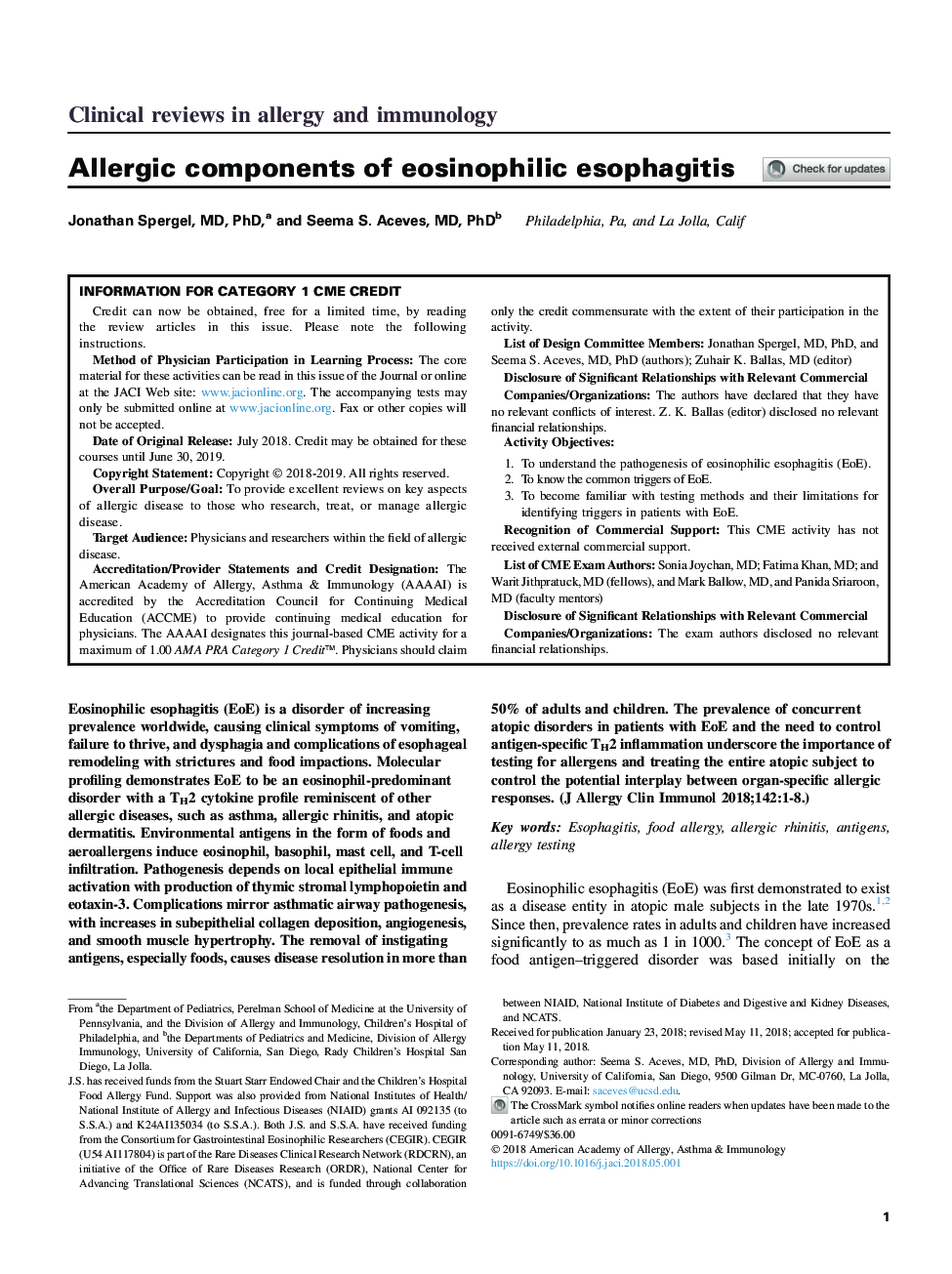| کد مقاله | کد نشریه | سال انتشار | مقاله انگلیسی | نسخه تمام متن |
|---|---|---|---|---|
| 8712983 | 1587101 | 2018 | 8 صفحه PDF | دانلود رایگان |
عنوان انگلیسی مقاله ISI
Allergic components of eosinophilic esophagitis
ترجمه فارسی عنوان
مولکول های آلرژیک از مریض ائوزینوفیل
دانلود مقاله + سفارش ترجمه
دانلود مقاله ISI انگلیسی
رایگان برای ایرانیان
کلمات کلیدی
PPIEoETSLPSLITISACPR-10Food allergy - آلرژی غذاییAntigens - آنتی ژنهاEsophagitis - اسفافیتSublingual immunotherapy - ایمونوتراپی زیر زبانیAllergy testing - تست آلرژیAllergic rhinitis - رینیت آلرژیکThymic stromal lymphopoietin - لنفوپیتین استروما تیمیکProton-pump inhibitor - مهارکننده پروتون-پمپeosinophilic esophagitis - یوزافاگیت ائوزینوفیل
موضوعات مرتبط
علوم زیستی و بیوفناوری
ایمنی شناسی و میکروب شناسی
ایمونولوژی
چکیده انگلیسی
Information for Category 1 CME CreditCredit can now be obtained, free for a limited time, by reading the review articles in this issue. Please note the following instructions.Method of Physician Participation in Learning Process: The core material for these activities can be read in this issue of the Journal or online at the JACI Web site: www.jacionline.org. The accompanying tests may only be submitted online at www.jacionline.org. Fax or other copies will not be accepted.Date of Original Release: July 2018. Credit may be obtained for these courses until June 30, 2019.Copyright Statement: Copyright © 2018-2019. All rights reserved.Overall Purpose/Goal: To provide excellent reviews on key aspects of allergic disease to those who research, treat, or manage allergic disease.Target Audience: Physicians and researchers within the field of allergic disease.Accreditation/Provider Statements and Credit Designation: The American Academy of Allergy, Asthma & Immunology (AAAAI) is accredited by the Accreditation Council for Continuing Medical Education (ACCME) to provide continuing medical education for physicians. The AAAAI designates this journal-based CME activity for a maximum of 1.00 AMA PRA Category 1 Creditâ¢. Physicians should claim only the credit commensurate with the extent of their participation in the activity.List of Design Committee Members: Jonathan Spergel, MD, PhD, and Seema S. Aceves, MD, PhD (authors); Zuhair K. Ballas, MD (editor)Disclosure of Significant Relationships with Relevant CommercialCompanies/Organizations: The authors have declared that they have no relevant conflicts of interest. Z. K. Ballas (editor) disclosed no relevant financial relationships.Activity Objectives:1.To understand the pathogenesis of eosinophilic esophagitis (EoE).2.To know the common triggers of EoE.3.To become familiar with testing methods and their limitations for identifying triggers in patients with EoE.Recognition of Commercial Support: This CME activity has not received external commercial support.List of CME Exam Authors: Sonia Joychan, MD; Fatima Khan, MD; and Warit Jithpratuck, MD (fellows), and Mark Ballow, MD, and Panida Sriaroon, MD (faculty mentors)Disclosure of Significant Relationships with Relevant CommercialCompanies/Organizations: The exam authors disclosed no relevant financial relationships.Eosinophilic esophagitis (EoE) is a disorder of increasing prevalence worldwide, causing clinical symptoms of vomiting, failure to thrive, and dysphagia and complications of esophageal remodeling with strictures and food impactions. Molecular profiling demonstrates EoE to be an eosinophil-predominant disorder with a TH2 cytokine profile reminiscent of other allergic diseases, such as asthma, allergic rhinitis, and atopic dermatitis. Environmental antigens in the form of foods and aeroallergens induce eosinophil, basophil, mast cell, and T-cell infiltration. Pathogenesis depends on local epithelial immune activation with production of thymic stromal lymphopoietin and eotaxin-3. Complications mirror asthmatic airway pathogenesis, with increases in subepithelial collagen deposition, angiogenesis, and smooth muscle hypertrophy. The removal of instigating antigens, especially foods, causes disease resolution in more than 50% of adults and children. The prevalence of concurrent atopic disorders in patients with EoE and the need to control antigen-specific TH2 inflammation underscore the importance of testing for allergens and treating the entire atopic subject to control the potential interplay between organ-specific allergic responses.
ناشر
Database: Elsevier - ScienceDirect (ساینس دایرکت)
Journal: Journal of Allergy and Clinical Immunology - Volume 142, Issue 1, July 2018, Pages 1-8
Journal: Journal of Allergy and Clinical Immunology - Volume 142, Issue 1, July 2018, Pages 1-8
نویسندگان
Jonathan MD, PhD, Seema S. MD, PhD,
